Unit 3
Magnetic Circuit
It involves the interaction of magnetic field and current carrying conductor placed in it. The operation sequence is as follow
- Development of individual field
- Interaction of two magnetic fields
- Force exerted on the conduction
- Development of individual field
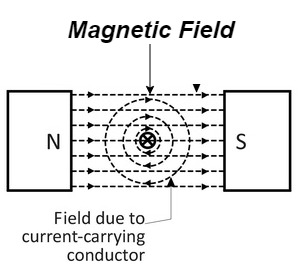
- Let a straight conductor is placed in the magnetic field produced by permanent magnet.
- Let current flowing through the conductor is out of the plane of the paper.
- The magnetic field produced by conductor is shown above
2. Interaction of two magnetic field
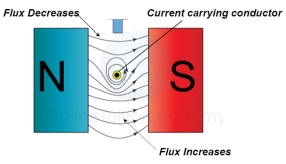
At the top flux lines produced by the magnet and conductor are in opposite direction to each other and hence cancel each other.
At the bottom individual fields are in same direction they will add each other.
3. Force excreted on the conductor

The lines of force on the bottom exert a force on the conductor in the upward direction as shown above.
Hence mechanical force is exerted on the conductor from high flux line area towards the low flux line area (top).
The magnetically of force experienced by the current carrying conductor placed in a magnetic field is given by
F = B I ɺ sin Ɵ newton
Where F = Force exerted
B = Flux density
ɺ = length of conductor
I = current
Ɵ = angle between conductor and magnetic field.
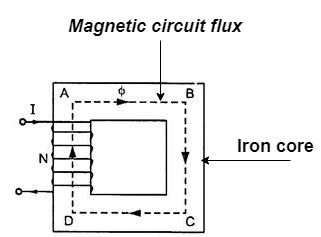
The magnetic circuit can be defined as the closed path traced by magnetic line of force such magnetic circuit is associated with different magnetic quantities such as MMF, flux, flux density, magnetic field strength
We know that H = 
And B = μ H
Put value of H
 B = μ x
B = μ x 
But μ = μₒμ
 B = μ₀μ
B = μ₀μ
But B =  = B x a
= B x a
Ø =
- Numerical on F = B I ɻ sin

Materials
- The atoms of ferromagnetic substances have permanent dipole moment present in domains.
- Atomic dipoles in ferromagnetic substances are oriented in the same direction as the external magnetic field.
- The magnetic dipole moment is large and is in the direction of the magnetizing field.
- The intensity of magnetization (M) is very large and positive and varies linearly with the magnetizing field (H). Hence saturation depends on the nature of the material.
- The magnetic susceptibility is very large and positive. Magnetic susceptibility Xm = M / H, where M is the intensity of magnetization and H is the strength of the applied magnetic field.
- The magnetic flux density of the material will be very large and positive. Magnetic field lines become very dense inside ferromagnetic materials. Magnetic flux density B = 0 (H + M), where 0 is the magnetic permittivity of free space, H is the strength of the applied magnetic field and M is the intensity of magnetization.
- The relative permeability is also very large and varies linearly with the magnetizing field the field inside the material is much stronger than the magnetizing field. They have a tendency of pulling in a large number of lines of force by the material. Relative permeability of material r = 1 + m
- Ferromagnetic substances are strongly attracted by the field. So in a nonuniform field, they have a tendency to stick at the poles where the field is strongest.
- If a ferromagnetic powder is placed in a watch glass placed on two poles pieces which are sufficient apart then powder accumulates at sides and shows depression in the middle because the field is strongest at poles.
- When a ferromagnetic substance is liquefied, it loses ferromagnetic properties due to higher temperature.
What is Self Induction?
When there is a change in the current or magnetic flux of the coil, an opposed induced electromotive force is produced. This phenomenon is termed as Self Induction. When the current starts flowing through the coil at any instant, it is found that that the magnetic flux becomes directly proportional to the current passing through the circuit. The relation is given as:
ϕ= I
ϕ = L I
Where L is termed as self-inductance of the coil or the coefficient of self-inductance. The self-inductance depends on the cross-sectional area, the permeability of the material or the number of turns in the coil.
The rate of change of magnetic flux in the coil is given as,

What is Mutual Induction?
We take two coils, and they are placed close to each other. The two coils are P- coil (Primary coil) and S- coil (Secondary coil). To the P-coil, a battery, and a key is connected wherein the S-coil a galvanometer is connected across it. When there is a change in the current or magnetic flux linked with two coils an opposing electromotive force is produced across each coil, and this phenomenon is termed as Mutual Induction. The relation is given as:
ϕ = I
ϕ = M I
Where M is termed as the mutual inductance of the two coils or the coefficient of the mutual inductance of the two coils.
The rate of change of magnetic flux in the coil is given as,

Magnetic field can be of permanent magnet or electro-magnet. Both magnetic fields store some energy. Permanent magnet always creates the magnetic flux and it does not vary upon the other external factors. But electromagnet creates its variable magnetic fields based on how much current it carries. The dimension of this electro-magnet is responsible to create the strength the magnetic field and hence the energy stored in this electromagnet.
First we consider the magnetic field is due to electromagnet i.e. a coil of several no. Turns. This coil or inductor is carrying current I when it is connected across a battery or voltage source through a switch.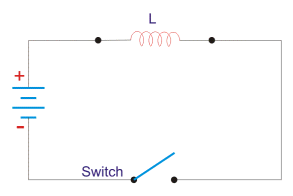
Suppose battery voltage is V volts, value of inductor is L Henry, and current I will flow at steady state.
When the switch is ON, a current will flow from zero to its steady value. But due to self induction a induced voltage appears which is
this E always in the opposite direction of the rate of change of current.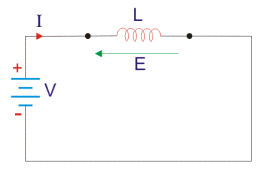
Now here the energy or work done due to this current passing through this inductor is U.
As the current starts from its zero value and flowing against the induced emf E, the energy will grow up gradually from zero value to U.
dU = W.dt, where W is the small power and W = – E.I
So, the energy stored in the inductor is given by
Now integrate the energy from 0 to its final value.
Again,
as per dimension of the coil, where N is the number of turns of the coil, A is the effective cross-sectional area of the coil and l is the effective length of the coil.
Again,
Where, H is the magnetizing force, N is the number of turns of the coil and l is the effective length of the coil.
Now putting expression of L and I in equation of U, we get new expression i.e.
So, the stored energy in a electromagnetic field i.e. a conductor can be calculated from its dimension and flux density.
The end to end connection of two or more inductors is called “series connection of inductors”. In this connection the inductors are connected in series so the effective turns of the inductor increase. The series connection of the inductors is shown in below diagram

The inductance of series connected inductors is calculated as the sum of the individual inductances of each coil since the current change through each coil is same.
This series connection is similar to that of the resistors connected in series, except the resistors are replaced by inductors. If the current I is flowing in the series connection and the coils are L1, L2, and so on, the common current in the series inductors is given by
ITotal = IL1 = IL2 = IL3. . . = In
If the individual voltage drops across each coil in this series connection are VL1, VL2, V¬L3, and so on, the total voltage drop between the two terminals VT is given by
VTotal = VL1 + VL2 + VL3…. + Vn
As we know that the voltage drop can be represented in terms of self inductance L, this implies
V = L di/ dt.
This can also be written as
LT di/dt = L1 di/dt + L2 di/dt + L3 di/dt + . . . + Ln di/dt
Therefore, the total inductance is
LTotal = L1 + L2 + L3 + ….. + Ln
Single Phase Transformer
I Ø transformers and electrostatics
- Types of transformers
Acc to input supply: I phase and  phase
phase
Acc to construction: core and shell type
Acc to 0/P: step up and step down
Construction of transformers (study only for MCQs)
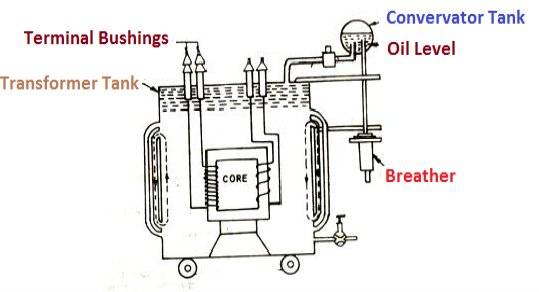
- Laminated steel core
Material used for core is (silicon steel) it is used for its (high permeability) and (low magnetic reluctance)  magnetic field produced is very strong
magnetic field produced is very strong
The core is formed of (stacks of laminated thin steel sheets) which are electrically isolated from each other. They are typically (0.35 to 0.5 mm thick)
We can used 2 ‘L’ shaped sheets or 2  shaped sheets for laminations
shaped sheets for laminations
Construction and types
- There a 2 types of winding
- Concentric or cylindrical
- Sandwiched type
- Cylindrical
L.V. = low voltage H.V. = high voltage are mounted on same limb to minimum leakage .

L.V. Winding placed inside and H.V. Winding placed outside with (proper insulation between the winding as it is easy to insulated L.V. Winding) than H.V. Winding.
2. Sandwiched
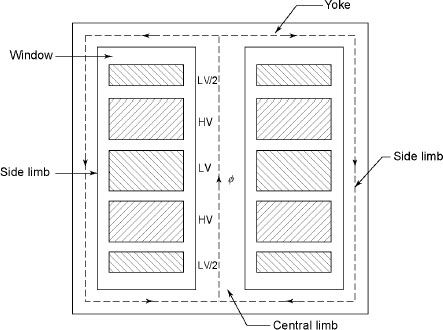
The H.V. And L.V. Winding are divided into no. Of small coils and there small windings are interleaved.
(the top and bottom winding are L.V. Coils because they are close to core)
- Transformer tank : wholes assembly of winding and core placed inside the Transformer tank (sheet metal tank) which is filled with Transformer oil or insulating oil which acts as an (insulator or coolant ) MCQ
- Transformer oil : (The function of oil is to remove efficiently the heat generated in core and in winding)
- Moisture should not be allowed which creeps the insulation which achieved by closed Transformer tank.
(To increase cooling surface are tubes or fins are provided)
- Conservator tank: above tank T/F tank there is one small tank in which same empty space is always provided above the oil level. (this space is required for oil to expand or contract due to temperature change) MCQ
However during contraction outside air can have moisture which will deteriorate the insulating properly of oil.
- Breather : the air goes in or out through the breather (To reduce the moisture content of their air . Same drying agents such as (silica gel or) calcium chloride) is used in the breather (The dust particles present in air are also removed by breather)
- Buccholz Relay : (for incipient (slowly increasing) faults
There is pipe connecting rain tank and conservator. On the pipe a protective device called Buccholz Relay is mounted.
When the Transformer is about to be faulty and draw range current the oil becomes very hot and decompose.
During this process different types of gases are liberated.(The Bucchoz Relay get operated by these gases) and gives an alarm to the operator. ɡȴ the fault continues to persist then there lay will trip off main circuit breaker to protect the Transformer.
- Explosion Vent :
An explosion Vent or relief value is the bent up pipe filled on the main tank.
(The explosion vent consist of aluminium of oil ) when the T/F becomes faulty the cooling oil get decomposed and various types of gases are liberated
(ɡȴ the gas pressure exodus certain level then the aluminium of oil (diagram) in explosion vent will burst) to release pressure. The will save main tank from getting damaged.
- Single phase transformer - for MCQs
(Symbol and principal of operation)
It is a static device which can transfer electrical energy from one ac circuit to another ac circuit without change in frequency
It can increase or decrease the voltage but with corresponding decrease or increase in current
It works on Principle 
“Mutual Induction”
A major application of transformer is to increase voltage before transmitting electrical energy over a long distance through conductors and to again reduce voltage at place where it is to be used.
Symbol
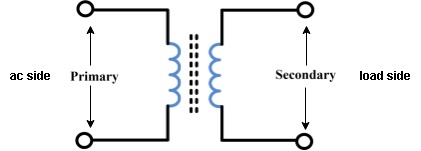
- Primary winding : (ac supply side) For MCQs
The winding which is connected to supply is called primary side
2. Secondary winding : (load side) for MCQs
The winding which is connected to load is called as secondary winding
It works on principle of mutual Induction ie “when 2 coil are inductively coupled and if current in one coil is changed uniformly then an emf get induced in another coil”
- When alternating voltage V1 is applied to primary winding am alternating current I1 flows in it producing alternating flux in the core.
- As per Faradays Law of Electromagnetic Induction 1 an emf E1 is induced in the primary winding E = N1

- The emf induced in the primary winding is nearly equal and opporite to applied voltage V1
- Assuming leakage flux to be negligible almost whole flux produced in primary winding links with secondary winding thence emf induced in the secondary winding E2 = N2

- Core and shall type transformers
Core Diagram

Shell Diagram:
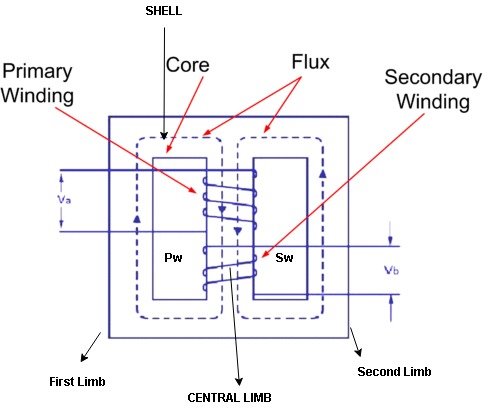
- It consist of magnetic frame with 1. 3 Limbs
2 limbs
2. single magnetic circuit 2. Double magnetic ckt.
3. Winding encircles the core 3. Core encircles the winding
4. One window 4. Two window
5. Cylindrical type winding is used 5. Sandwich type is used
6. Easy to repair 6. Not easy repair
7. Preferred for Low voltage application 7. Preferred for high voltage application
8. Provides better cooling since winding 8. Does not provide effective cooling as
Are uniformly distributed on 2 limbs the winding are surrounding core.
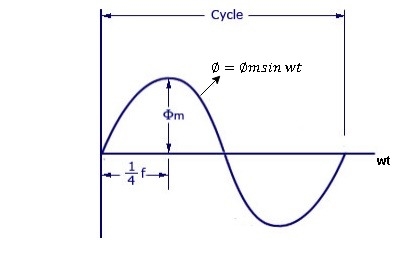
As primary winding excited by the a sinusoidal alternating voltage an alternating current flows in the winding producing an alternating varying flux Ø
Ø = Øm sin wt
As per Faradays Law of Electromagnetic Induction emf E1 is induced
E1 = N1 
E1 = N1  (Ø Sin wt)
(Ø Sin wt)
= - N1 Øm w Cos wt
Sin (90-wt)
= - Sin (wt-90)
 E1 = N1 Øm w Sin (wt-90)
E1 = N1 Øm w Sin (wt-90)
 w =
w = 
 E1 =
E1 =  N1 Ø m Sin (wt-90)
N1 Ø m Sin (wt-90)
Max value of E1 = E max
Is when Sin (wt-90) =  1
1
E1 max =  N1 Ø m
N1 Ø m
Hence rms value of induced EMF in primary winding
E1 rms =  =
= 
 E1 = 4.44 F Ø m N1
E1 = 4.44 F Ø m N1
 Similarly RMS value of induced EMF in secondary wdg Is
Similarly RMS value of induced EMF in secondary wdg Is
E2 = 4.44 F Ø m N2
For drawing equivalent circuit of transformer referred to primary, first establish general equivalent circuit of transformer then, modify it for referring from primary side. The vector diagram of transformer which is shown in the figure.
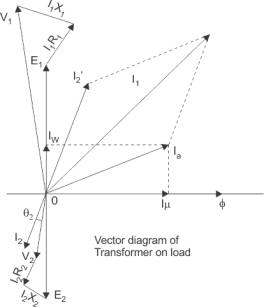
Let us consider the transformation ratio be,
K = N1/N2 = E1/E2
In the figure the applied voltage to the primary is V1 and voltage across the primary winding is E1. Total current supplied to primary is I1. So, the voltage V1 applied to the primary is partly dropped by
I1Z1 or I1R1 + j.I1X1 before it appears across primary winding.
The voltage appeared across winding is countered by primary induced emf E1.
So, voltage equation of this portion of the transformer can be written as,
V1 – (I1 R1 + j I1 X1 ) = E1
The equivalent circuit for the equation can be drawn as

From the vector diagram it is found that the total primary current I1 has two components, one is no – load component Io and the other is load component I2′.
As this primary current has two components or branches, so there must be a parallel path with primary winding of transformer.
This parallel path of current is known as excitation branch of equivalent circuit of transformer. The resistive and reactive branches of the excitation circuit can be represented as
R0 = E1/ Iw and Xo = E1/ I μ
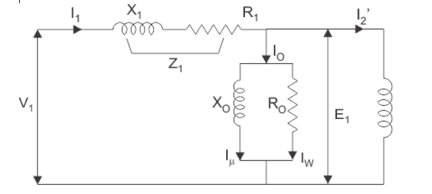
The load component I2′ flows through the primary winding of transformer and induced voltage across the winding is E1 as shown in the figure right. This induced voltage E1 transforms to secondary and it is E2 and load component of primary current I2′ is transformed to secondary as secondary current I2. Current of secondary is I2. So, the voltage E2 across secondary winding is partly dropped by
I2Z2 or I2R2 + j.I2X2 before it appears across load.
The load voltage is V2.
The complete equivalent circuit of transformer is shown below.

Now if we see the voltage drop in secondary from primary side, then it would be ′K′ times greater and would be written as K.Z2.I2.
Again I2′.N1 = I2.N2
I2 = I2’ N1/N2
I2 = K I’2
Therefore,
K Z 2 I 2 = K Z 2 K I 2’ = K 2 Z 2 I 2 ‘
From above equation, secondary impedance of transformer referred to primary is,
Z 2’ = K 2 Z 2
Hence R2’ = K2 R2 and X2 = K 2 X 2
So, the complete equivalent circuit of transformer referred to primary is shown in the
Figure below.

Voltage regulation:
The change in secondary terminal voltage from no load to full load condition expressed as fraction of no load secondary voltage is called as voltage regulation
 regulation =
regulation = 

- Losses in a Transformer
There are 2 types of losses occurring in a transformer
A) 1. Core loss or Iron loss
B) 2. Copper loss
- Core losses:
- This loss is due to the reversal of flux
- The flux set up in the core is dependent on the i/p supply
 as the i/p supply is constant in magnitude
as the i/p supply is constant in magnitude  the flux set up will be constant and
the flux set up will be constant and  core losses are also constant.
core losses are also constant. - Core losses are voltage dependent loss they can be subdivided in 2
1 Hysteresis loss
2 reedy current loss
- Hysteresis loss : The iron loss occurring in the core of T/F due to the Hysteresis curve of the magnetic material used for core is called as Hysteresis loss.
Hysteresis curve is the curve as loop which shows the properly of magnetic material to lag the flux density B behind the field Intensely H
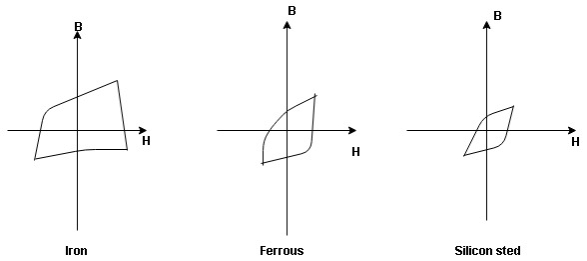
Above is the 3 different loops (Hysteresis of 3 diff. Materials)
 the selection of magnetic material for the construction of core depends upon Hysteresis loop of that material having tall and narrow Hysteresis loop is selected for the T/F core
the selection of magnetic material for the construction of core depends upon Hysteresis loop of that material having tall and narrow Hysteresis loop is selected for the T/F core
 silicon Steel
silicon Steel
Hysteresis loss depends on fold factor
PH = KH. Bm1.67 F  V – watts
V – watts
Where KH = constant (Hyst)
Bm = max Flux density
F = Frequency
 = Volume of core.
= Volume of core.
2. Reedy current loss :
This loss is due to the flow of reedy (circular) current in the core caused by induced emf in core
PE = Ke Bm2 f2 t2 v – watts
Where
Ke = reedy current const.
t = thickness of core
It can be reduced by using stacks of laminations instead of solid core
B] Copper loss : PCU
The Copper loss is due to resistance of the primary and secondary winding
It is load dependent / current dependent loss
As load on a transformer is variable (changing)  current changes
current changes  copper loss is a variable loss
copper loss is a variable loss
Primary secondary
Total C is loss = I12 R12 + I22 R22
Copper loss depends upon load on T/F and is proportional to square of load current or KVA rating of transformer
 PCU
PCU  2
2  (KVA)2
(KVA)2
F.L = full load
 PCU (at half load) =
PCU (at half load) =  2 PCu F.L
2 PCu F.L
= (0.5)2 PCU F.L.
Or PCu ( load) = (
load) = ( )2 PCu F.L
)2 PCu F.L
Vat ampere rating / rating of transformer for MCQs
As the rating decides the O/P power of any machine and the o/p power depends upon the efficiency of that machine which depends upon losses of the machine
- As the transformer losses depends on voltage and current, the rating of transformer is specified as the product of voltage and current called as V I rating / VA rating
- The rating of T/F indicates the output power from it but transformer load is not fixed
Hence rating of transformer is not expressed in terms of power but in terms of product of voltage and current called as VA rating
The rating is expressed as KVA rating
 rating of T/F KVA =
rating of T/F KVA =  =
= 
 full load primary current
full load primary current
 1 =
1 = 
Full load secondary current
 2 =
2 =  for MCQs numerical
for MCQs numerical
Efficiency : it is the ratio output power to input power of transformer
 =
= 
Output power = input power – total loss
 Input power = O/P + losses
Input power = O/P + losses

O/P power = KVA  Cos Ø2
Cos Ø2  1000
1000
Or = V2  I2 Cos Ø2
I2 Cos Ø2
Losses = Pi + PCU (F.L)
= iron + copper loss
 Full load =
Full load = 
 Half load(H.L) or 50% or 0.5 =
Half load(H.L) or 50% or 0.5 = 

 =
= 
Maximum efficiency – for numerical :
The efficiency of T/F is maximum when copper loss equates iron loss this is the condition for max efficiency
Ie Pi = PCU
 =
= 
 PCU = Pi at max n
PCU = Pi at max n
Where KVA at max n given = Full load KVA 

Open circuit test:
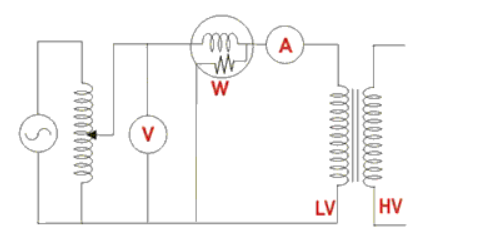
The connection diagram for open circuit test on transformer is shown in the figure. A voltmeter, wattmeter, and an ammeter are connected in LV side of the transformer as shown. The voltage at rated frequency is applied to that LV side with the help of a variac of variable ratio auto transformer.
The HV side of the transformer is kept open. Now with the help of variac, applied voltage gets slowly increased until the voltmeter gives reading equal to the rated voltage of the LV side. After reaching rated LV side voltage, we record all the three instruments reading (Voltmeter, Ammeter and Wattmeter readings).
The ammeter reading gives the no load current Ie. As no load current Ie is quite small compared to rated current of the transformer, the voltage drops due to this current that can be taken as negligible.
Since voltmeter reading V1 can be considered equal to the secondary induced voltage of the transformer, wattmeter reading indicates the input power during the test.
As the transformer is open circuited, there is no output, hence the input power here consists of core losses in transformer and copper loss in transformer during no load condition. The no-load current in the transformer is quite small compared to the full load current so, we can neglect the copper loss due to the no-load current.
Hence, can take the wattmeter reading as equal to the core losses in the transformer.
Let us consider wattmeter reading is Po.
Po = V1 2 / Rm
Where Rm is the shunt branch resistance of the transformer.
If Zm is the shunt branch resistance of the transformer
Zm = V1/ Ie
Therefore, if shunt branch reactance of transformer is Xm,
Then (1/Xm ) 2 = (1/Zm) 2 – (1/Rm ) 2
These values are referred to the LV side of the transformer due to the tests being conducted on the LV side of transformer.